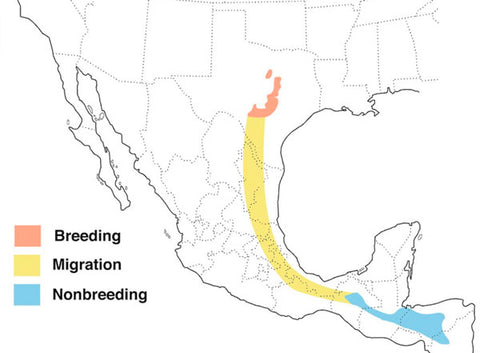Welcome to royalemaps.com, today we return to the natural treasures of Texas. In this blog post, I will look at the captivating world of the Golden-Cheeked Warbler, a rare and endangered bird species that calls the Lone Star State home and ornates our Map of Texas with its golden plumage!
Where can I find the Golden-Cheeked Warbler?
The Golden-Cheeked Warbler, scientifically known as Setophaga chrysoparia, is a migratory songbird endemic to Central Texas. Its preferred habitat is the mature juniper-oak woodlands of the Texas Hill Country, where it nests and breeds during the spring and summer months.

Why is the Golden-Cheeked Warbler endangered?
The Golden-Cheeked Warbler is listed as an endangered species due to habitat loss and fragmentation caused by urbanization, agriculture, and land development. The destruction of its preferred nesting habitat, the Ashe juniper (cedar) trees found in the Texas Hill Country, has sadly significantly reduced its population and range.
Several measures are now in place to protect the Golden-Cheeked Warbler. Under the Endangered Species Act (ESA), legal protections safeguard the bird and its habitat, while Habitat Conservation Plans (HCPs) mitigate human activities impacting its habitat. Designated protected areas within state parks and wildlife management areas provide essential nesting grounds, supported by public awareness campaigns and educational initiatives.
What is special about the Golden-Cheeked Warbler?

The Golden-Cheeked Warbler is renowned for its striking appearance, with bright golden-yellow markings on its cheeks and black streaking on its back and wings. It is the only bird species that nests exclusively in Texas and is considered a symbol of the state's natural heritage and biodiversity.
How does the Golden-Cheeked Warbler contribute to the Texan wildlife ecosystem?
As a key indicator species of healthy juniper-oak woodlands, the Golden-Cheeked Warbler plays a crucial role in maintaining ecological balance in its habitat. By foraging for insects and larvae and nesting in mature cedar trees, it helps regulate insect populations and supports the overall health of the forest ecosystem.
How can you spot a Golden-Cheeked Warbler?
Spotting a Golden-Cheeked Warbler requires patience and keen observation. Look for these elusive birds in mature juniper-oak woodlands, particularly during the breeding season from March to July. Listen for their distinctive song, which is a series of high-pitched notes followed by a trill.

How long does the Golden-Cheeked Warbler live?
The lifespan of a Golden-Cheeked Warbler varies, but they typically live for around 5 to 7 years in the wild. However, factors such as predation, habitat quality, and environmental conditions can influence their longevity.
Legends surrounding the Golden Cheeked Warbler.
I love myths and legends, so I had to look this one up! Legend has it that the Golden-Cheeked Warbler is a guardian spirit of the Texas Hill Country, protecting the forests and wildlife from harm. According to ancient tales, the appearance of these majestic birds is a sign of harmony and balance in the natural world. As guardians of the forest, the Golden-Cheeked Warblers are said to possess magical powers that protect the land from harm and ensure the well-being of its inhabitants. Their melodious songs are believed to have the power to heal the sick, soothe troubled minds, and inspire creativity and renewal in all who hear them. I have found a sample of the Golden-Cheeked Warbler song here.
The Golden-Cheeked Warbler stands as a beacon of hope and resilience in the face of adversity. By raising awareness of its plight and taking action to conserve its habitat, we can ensure that future generations continue to marvel at the beauty and grace of this magnificent bird. Join us in celebrating the Golden-Cheeked Warbler and preserving its legacy for generations to come by investing in our Map of Texas!


